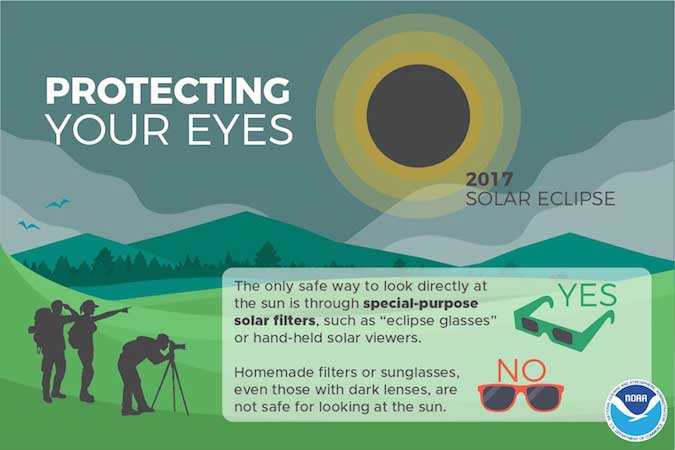NASA has safety tips for observing a solar eclipse

Courtesy of The National Oceanic and Atmospheric Administration
(Editor’s Note: The solar eclipse will begin at 1:11 p.m. with maximum amount of sun coverage occurring at 2:33 p.m. The eclipse end at 3:51 p.m.)
NASA has issued the following safety information for observing today’s solar eclipse:
Looking directly at the Sun is unsafe except during the brief total phase of a solar eclipse (totality), when the Moon entirely blocks the Sun’s bright face, which will happen only within the narrow path of totality.
• The only safe way to look directly at the uneclipsed or partially eclipsed Sun is through special-purpose solar filters, such as eclipse glasses or hand-held solar viewers. Homemade filters or ordinary sunglasses, even very dark ones, are not safe for looking at the Sun.
To date four manufacturers have certified that their eclipse glasses and handheld solar viewers meet the ISO 12312-2 international standard for such products: Rainbow Symphony, American Paper Optics, Thousand Oaks Optical, and TSE 17.
• Always inspect your solar filter before use. If it is scratched or damaged, discard it. Read and follow any instructions printed on or packaged with the filter. Always supervise children using solar filters.
• Stand still and cover your eyes with your eclipse glasses or solar viewer before looking up at the bright Sun. After glancing at the Sun, turn away and remove your filter — do not remove it while looking at the Sun.
• Do not look at the uneclipsed or partially eclipsed Sun through an unfiltered camera, telescope, binoculars, or other optical device. Similarly, do not look at the Sun through a camera, a telescope, binoculars, or any other optical device while using your eclipse glasses or hand-held solar viewer — the concentrated solar rays will damage the filter and enter your eye(s), causing serious injury. Seek expert advice from an astronomer before using a solar filter with a camera, a telescope, binoculars, or any other optical device.
• If you are within the path of totality, remove your solar filter only when the Moon completely covers the Sun’s bright face and it suddenly gets quite dark. Experience totality, then, as soon as the bright Sun begins to reappear, replace your solar viewer to glance at the remaining partial phases.
• An alternative method for safe viewing of the partially eclipsed Sun is pinhole projection. For example, cross the outstretched, slightly open fingers of one hand over the outstretched, slightly open fingers of the other. With your back to the Sun, look at your hands’ shadow on the ground. The little spaces between your fingers will project a grid of small images on the ground, showing the Sun as a crescent during the partial phases of the eclipse.
A solar eclipse is one of nature’s grandest spectacles. By following these simple rules, you can safely enjoy the view and be rewarded with memories to last a lifetime.







































































